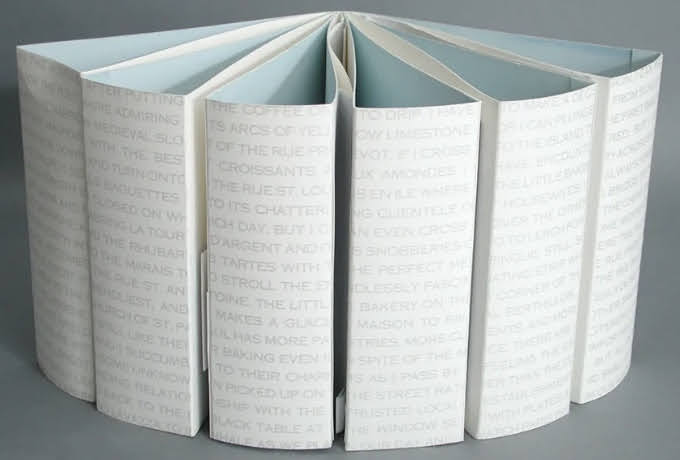Mei-Ling Hom’s In the morning looks nothing like the books we’re used to seeing, which is what’s so eye-catching about it.
Women’s Studio Workshop describes it as a “three dimensional, semi-circular book with pie shaped pages that has text printed on the exploded fore edge.” If one were to wedge their fingers in between two pieces of pie, they’re greeted with a white pop-up that represents something the author experienced in Paris.

I think what’s so appealing to me about this book is that it’s very much something a publisher would consider for a children’s book because of the interactive element and the fact that it’s a pop-up book. In fact, Women’s Studio Workshop lists this under “Toy and movable books.”
While the book speaks personally about the author’s experience in Paris, I rather like the lack of words — or paragraphs, rather. Some may not like this approach, I think it’s a rather bold and creative of Hom because it forces us to take something out of it from our own interpretation rather than being told what we should see. We only see words on the outside of the book, and it seems to be only one scene out of what I assume would be many, considering we have multiple images inside the pie. The filling is the pop-up portion, but it reminds me a lot of the vignette writing technique. We’re given images, but they’re not exactly clear. They’re rather abstract, especially since the pop-ups are white against a white background; very minimalist and clean-cut use of silkscreen, letterpress, and die cuts.

Another thing that interests me is the binding. It’s listed as, “Folded pages connected together at spine.” As we were creating accordion books in class, I wondered if this is a complicated accordion technique Hom created or was inspired by. Like an accordion book, there’s no exact starting or ending point. The reader could start at either end or even in the middle and would still understand the gist of the story, if there even is a story in it.
Sources:
Hom, Mei-Ling. (1990.) In the morning. Women’s Studio Workshop. Retrieved September 28, 2021, from https://wsworkshop.org/collection/in-the-morning/.

I like how abstract the artist’s book is, especially since you can get a number of different meanings from it. The way you compared it to an accordion book is really cool, and I can totally see what you mean! Placing white on white inside the book and keeping the text all on the outside of the book is a really interesting concept, and I’d love to get a chance to speak with the artist to learn more about the idea behind the concept!
LikeLike
I’ve always thought that pop-up books were neat, and the way that the author combines it with an accordion style book is fitting, since both rely on clever folding and cutting. I’ve done a decent amount of paper cutting, and I know that pop-up books and accordion books use similar types of folds. Hom’s book is a clever combination of the two techniques.
LikeLike
This book is so different, and I love it. It draws attention to the book as object because it is so unique, and it really does capture the essence of what’s inside because it quite literally does look like a pie. It’s interesting that this is generally something we would consider a children’s book just for its form as a book object. When do we move away from more childish understandings of what a book can be and into the more adult understandings of what a book is based upon convention? What role does content play in determining the place of a book and its readership? I also love that the book challenges the traditional sequence. It’s not often that you can pick up a book anywhere and instantly be immersed in it, discarding the idea that we must start from the beginning. It’s almost like a book such as this could rewrite our conceptions of time, which we often conceive of as linear… I love this book! It is so cool!
LikeLike